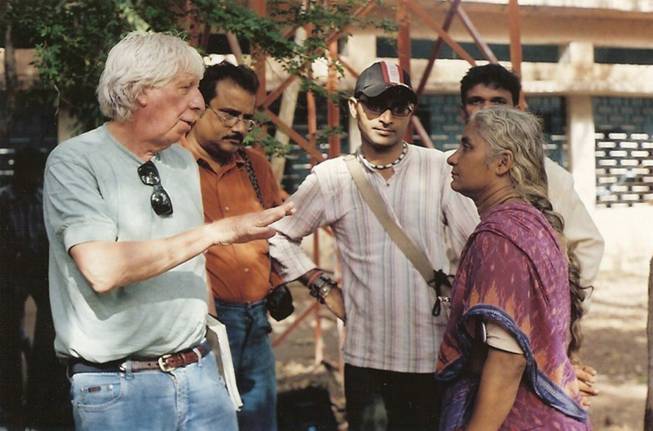
PUBLICITY PHOTO
Filmmaker Jim Thebaut, left, gives directions while shooting an educational movie in India. Thebaut’s latest project is a collaboration with a local water agency.
Tuesday, Sept. 23, 2008 | 2 a.m.
Where to watch
Vegas PBS Channel 10
- Tuesday, Oct. 7, 9 p.m.
- Thursday, Oct. 9, 10 p.m.
- Sunday, Oct. 12, 6:30 p.m.
- Thursday, Oct. 30, 9 p.m.
Sun Topics
Beyond the Sun
Jim Thebaut wants to be the Pied Piper of water conservation.
“If we can reach the children, the parents will fall in line,” says the filmmaker, a self-described ecologist and journalist and a former environmental planner.
That’s why Thebaut is working with the Southern Nevada Water Authority and the Metropolitan Water District of Southern California to create a curriculum to teach children where their water comes from and how to conserve it. The two regional water agencies have contributed $150,000 each, covering half the budget of his recent movie about the Southwest’s water crisis.
“The American Southwest: Are We Running Dry?” details the ill effects of a drought that has plagued the region for nearly a decade.
The Southern Nevada Water Authority will sponsor a screening of the 71-minute film during October’s WaterSmart Innovations conference in Las Vegas, and a 56-minute version will air for the first time on Vegas PBS at 9 p.m. Oct. 7. Also airing on PBS that night will be Liquid Assets, a film about the country’s aging water infrastructure and how a breakdown in the system could jeopardize our water supply.
The movie, a sequel to a Thebaut film about global water shortages, is intended to be a component of a comprehensive public education program.
“We don’t teach our kids the basics of ecology. Where does water come from? Where does it go when it leaves your house?” Thebaut said. “These are important fundamentals that everyone should know.”
One reason children and parents don’t know enough about water shortages is that every time they turn on the tap, water flows.
“Our utilities, like SNWA or Metropolitan, have done such a great job of delivering such a wonderful product, clean and at a very low cost, that the American public has always taken water for granted,” Thebaut said. We take “endless showers, yet we really do have a crisis and a limitation.”
After presenting his first water film, “Running Dry: The Global Water Crisis,” around the world, Thebaut realized he needed to educate Americans about domestic water challenges.
“American people have a tendency to kind of look at the rest of the world in an abstract way. ‘That’s Africa, that’s China, that’s India. That has nothing to do with us,’ ” he said. “We have problems in our own back yard. We don’t have to go to Latin America or Africa to discover we have Third World problems right here.”
The Southwest film, for example, details the daily struggles to get potable water on Arizona’s Hopi and Navajo Indian reservations.
Thebaut said he’s hopeful that once he gets “into the psyche and soul of the American public, they’ll turn around and start conserving. I think they will come around.”
He said he’s working with the Water Authority to train teachers across the Southwest in how to educate children about water shortages.
“The film underscores in a compelling way the severity of the Southwest’s water crisis and the need for innovative, cooperative solutions,” said a statement from Pat Mulroy, the Water Authority’s general manager. “Exposing our children to this reality is beneficial because the next generation of leaders will come from this group, and we want them to be prepared for the challenges that lie ahead.”
The film depicts water shortages in Nevada, Arizona and California, covers the basics of the Colorado River Compact, and includes discussions about seawater desalination and water recycling.
But one topic the film doesn’t cover is Southern Nevada’s controversial plan to pump thousands of acre-feet of water a year from eastern Nevada to Las Vegas.
Thebaut said he and Mulroy have discussed ground-water pumping, which environmentalists and rural ranchers say would devastate plant and animal life and deplete the Great Basin’s major aquifer.
“She is scrambling to do whatever she can to bring water into Southern Nevada,” Thebaut said.
His movie warns of some of the risks of ground-water withdrawal in general, but he chose to focus on declining water levels in Lake Mead and possible long-term solutions such as desalination, rather than the pipeline.
Although Thebaut won’t go so far as to say Las Vegas shouldn’t exist in the harsh Mojave, he does say: “We should have adapted to living in the environment we have instead of re-creating the whole region. You start messing with Mother Nature and you really have problems.”

Join the Discussion:
Check this out for a full explanation of our conversion to the LiveFyre commenting system and instructions on how to sign up for an account.
Full comments policy